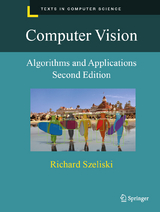Computer Vision
Algorithms and Applications
Seiten
2010
Springer London Ltd (Verlag)
978-1-84882-934-3 (ISBN)
Springer London Ltd (Verlag)
978-1-84882-934-3 (ISBN)
- Titel erscheint in neuer Auflage
- Artikel merken
Zu diesem Artikel existiert eine Nachauflage
Humans perceive the three-dimensional structure of the world with apparent ease. This title explores the variety of techniques commonly used to analyze and interpret images. It also describes challenging real-world applications where vision is being successfully used, both for specialized applications such as medical imaging, and for fun.
Computer Vision: Algorithms and Applications explores the variety of techniques commonly used to analyze and interpret images. It also describes challenging real-world applications where vision is being successfully used, both for specialized applications such as medical imaging, and for fun, consumer-level tasks such as image editing and stitching, which students can apply to their own personal photos and videos.
More than just a source of “recipes,” this exceptionally authoritative and comprehensive textbook/reference also takes a scientific approach to basic vision problems, formulating physical models of the imaging process before inverting them to produce descriptions of a scene. These problems are also analyzed using statistical models and solved using rigorous engineering techniques.
Topics and features: structured to support active curricula and project-oriented courses, with tips in the Introduction for using the book in a variety of customized courses; presents exercises at the end of each chapter with a heavy emphasis on testing algorithms and containing numerous suggestions for small mid-term projects; provides additional material and more detailed mathematical topics in the Appendices, which cover linear algebra, numerical techniques, and Bayesian estimation theory; suggests additional reading at the end of each chapter, including the latest research in each sub-field, in addition to a full Bibliography at the end of the book; supplies supplementary course material for students at the associated website, http://szeliski.org/Book/.
Suitable for an upper-level undergraduate or graduate-level course in computer science or engineering, this textbook focuses on basic techniques that work under real-world conditions and encourages students to push their creative boundaries. Its design and exposition also make it eminently suitable as a unique reference to the fundamental techniques and current research literature in computer vision.
Computer Vision: Algorithms and Applications explores the variety of techniques commonly used to analyze and interpret images. It also describes challenging real-world applications where vision is being successfully used, both for specialized applications such as medical imaging, and for fun, consumer-level tasks such as image editing and stitching, which students can apply to their own personal photos and videos.
More than just a source of “recipes,” this exceptionally authoritative and comprehensive textbook/reference also takes a scientific approach to basic vision problems, formulating physical models of the imaging process before inverting them to produce descriptions of a scene. These problems are also analyzed using statistical models and solved using rigorous engineering techniques.
Topics and features: structured to support active curricula and project-oriented courses, with tips in the Introduction for using the book in a variety of customized courses; presents exercises at the end of each chapter with a heavy emphasis on testing algorithms and containing numerous suggestions for small mid-term projects; provides additional material and more detailed mathematical topics in the Appendices, which cover linear algebra, numerical techniques, and Bayesian estimation theory; suggests additional reading at the end of each chapter, including the latest research in each sub-field, in addition to a full Bibliography at the end of the book; supplies supplementary course material for students at the associated website, http://szeliski.org/Book/.
Suitable for an upper-level undergraduate or graduate-level course in computer science or engineering, this textbook focuses on basic techniques that work under real-world conditions and encourages students to push their creative boundaries. Its design and exposition also make it eminently suitable as a unique reference to the fundamental techniques and current research literature in computer vision.
Dr. Richard Szeliski has more than 25 years’ experience in computer vision research, most notably at Digital Equipment Corporation and Microsoft Research. This text draws on that experience, as well as on computer vision courses he has taught at the University of Washington and Stanford.
Introduction.- Image Formation.- Image Processing.- Feature Detection and Matching.- Segmentation.- Feature-based Alignment.- Structure from Motion.- Dense Motion Estimation.- Image Stitching.- Computational Photography.- Stereo Correspondence.- 3D Reconstruction.- Image-based Rendering.- Recognition.
| Erscheint lt. Verlag | 19.10.2010 |
|---|---|
| Reihe/Serie | Texts in Computer Science |
| Zusatzinfo | 560 Illustrations, color; 14 Illustrations, black and white; XX, 812 p. 574 illus., 560 illus. in color. |
| Verlagsort | England |
| Sprache | englisch |
| Maße | 210 x 279 mm |
| Gewicht | 3136 g |
| Themenwelt | Informatik ► Grafik / Design ► Digitale Bildverarbeitung |
| Informatik ► Theorie / Studium ► Künstliche Intelligenz / Robotik | |
| ISBN-10 | 1-84882-934-5 / 1848829345 |
| ISBN-13 | 978-1-84882-934-3 / 9781848829343 |
| Zustand | Neuware |
| Haben Sie eine Frage zum Produkt? |
Mehr entdecken
aus dem Bereich
aus dem Bereich
Buch | Hardcover (2012)
Westermann Schulbuchverlag
34,95 €
Schulbuch Klassen 7/8 (G9)
Buch | Hardcover (2015)
Klett (Verlag)
30,50 €
Buch | Softcover (2004)
Cornelsen Verlag
25,25 €





